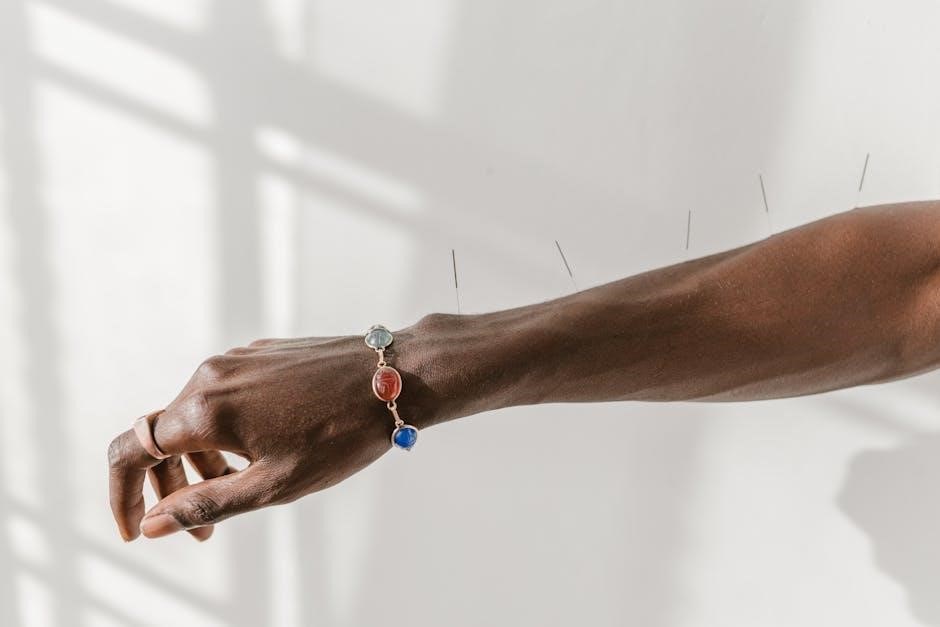
What is Integrative Manual Therapy (IMT)?
Integrative Manual Therapy (IMT) is a unique compilation of diagnostic and treatment methodologies that assess and treat pain, dysfunction, disease, and disability using gentle, non-invasive techniques․
Definition and Overview
Integrative Manual Therapy (IMT) is a comprehensive healthcare approach developed to address the needs of complex patients by identifying and treating the underlying causes of pain, dysfunction, disease, and disability․ It uses a unique set of non-invasive techniques and methodologies that work within the body․ The goal is to find and treat the root cause of the issues, not just the symptoms․
IMT encompasses a wide range of healthcare practices, achieving health and healing by taking into account all systems of the body․ Developed by Dr․ Sharon Giammatteo, IMT guides the body’s homeostasis to a superior level, returning it to optimal health․ IMT works with all systems of the body․
Core Principles of IMT
The core principle of Integrative Manual Therapy (IMT) is that most health problems, whether minor or chronic, stem from blockages and dysfunctions that hinder the body’s natural self-healing capabilities․ IMT recognizes the body as an interconnected whole, addressing physical, functional, and psychological aspects through gentle touch; This holistic approach considers all body systems, including bone, nerve, fascia, muscle, organ, lymph, and circulatory systems․
IMT utilizes tissue-distinct techniques to optimize healing, acknowledging that each tissue type has unique requirements․ Therapists treat the body as a whole, seeking the root cause of problems rather than just addressing symptoms․ Practitioners use advanced palpation techniques to promote tissue repair, normalize structure, and restore function․
Key Components and Methodologies
IMT employs a unique set of non-invasive techniques, approaches, and methodologies that work from within the body to find and treat the root cause of pain, dysfunction, disease, and disability․
Diagnostic Methodologies in IMT
Integrative Manual Therapy (IMT) utilizes a unique compilation of diagnostic methodologies to assess pain, dysfunction, disease, and disability․ These methodologies involve advanced and gentle palpation techniques to identify structural and functional imbalances within the body’s systems․ Practitioners use their hands to assess tissue tension, movement restrictions, and other indicators of dysfunction․
IMT diagnostic approaches consider the body as a whole, recognizing the interconnectedness of various systems․ The evaluation includes assessing bone, nerve, fascia, muscle, organ, lymph, and circulatory systems․ Each tissue type has unique requirements for healing, and IMT diagnostic methods aim to identify the specific needs of each tissue․
The diagnostic process is a crucial step in developing a treatment plan that addresses the underlying causes of the patient’s condition․ IMT practitioners focus on finding the root cause of pain and dysfunction rather than solely addressing the symptoms․
Treatment Techniques Employed
Integrative Manual Therapy (IMT) employs a diverse range of gentle, non-invasive techniques to address pain, dysfunction, disease, and disability․ These techniques are tailored to the specific needs of each patient and are designed to promote tissue repair, normalize structure, and restore function․ IMT treatment approaches work with all body systems to guide the body’s homeostasis to a superior level․
IMT techniques include gentle manipulation and mobilization of tissues to release restrictions and improve movement․ These techniques are applied to bone, nerve, fascia, muscle, organ, lymph, and circulatory systems․ Each tissue type has unique requirements for healing, and IMT uses tissue-distinct techniques to yield optimal results․
The goal of IMT treatment is to address the underlying causes of the patient’s condition, rather than simply treating the symptoms․ By restoring balance and function to the body’s systems, IMT aims to promote long-lasting healing and optimal health․
Focus on All Body Systems
Integrative Manual Therapy (IMT) distinguishes itself by adopting a holistic approach, emphasizing the interconnectedness of all bodily systems․ Unlike therapies that focus solely on specific areas, IMT considers the entire body as a single, integrated unit․ Practitioners recognize that dysfunction in one system can impact others, creating a cascade of imbalances․
This comprehensive approach involves assessing and treating the musculoskeletal, nervous, vascular, lymphatic, and visceral systems․ IMT aims to restore optimal function to each system, recognizing that their interdependence is vital for overall health and well-being․ By addressing the root causes of dysfunction, IMT facilitates the body’s natural ability to heal and restore balance;
Through gentle, hands-on techniques, IMT practitioners work to release restrictions, improve circulation, and enhance communication between systems․ This holistic focus allows for a more thorough and effective treatment, promoting long-term relief and improved quality of life․

The Role of Dr․ Sharon Giammatteo
Dr․ Sharon Giammatteo developed Integrative Manual Therapy (IMT) over 30 years, creating a unique healthcare approach to address complex patients’ needs, encompassing diverse health practices․
Dr․ Giammatteo’s Contribution to IMT Development
Dr․ Sharon Giammatteo is the driving force behind the creation and evolution of Integrative Manual Therapy (IMT)․ Her decades-long dedication has shaped IMT into a comprehensive healthcare process․ Giammatteo’s work integrates various manual therapy approaches, addressing all body systems to restore physical, functional, and psychological well-being․
Her unique compilation of diagnostic and treatment methodologies assesses and treats pain, dysfunction, disease, and disability․ IMT, developed by Dr․ Giammatteo, focuses on treating the root cause of health problems through gentle touch․ Giammatteo’s innovative techniques work to guide the body towards homeostasis․
Her contribution provides a structural and functional approach to rehabilitation, achieving long-lasting results․ Dr․ Giammatteo’s work emphasizes the importance of treating the body as a whole․

Benefits of Integrative Manual Therapy
Integrative Manual Therapy offers numerous benefits, addressing pain, dysfunction, and disability through gentle, non-invasive techniques․ IMT restores homeostasis, promoting optimal health and overall well-being in individuals․
Addressing Pain, Dysfunction, and Disability
Integrative Manual Therapy (IMT) offers a comprehensive approach to addressing pain, dysfunction, and disability by identifying and treating the root causes of these issues․ Unlike conventional methods that often focus solely on symptom management, IMT delves deeper to uncover underlying imbalances within the body’s interconnected systems․ This holistic perspective allows IMT practitioners to develop targeted treatment plans that promote long-term relief and improved function․
Through gentle, hands-on techniques, IMT aims to release blockages and restore proper movement and alignment throughout the body․ By addressing these underlying structural and functional impairments, IMT can effectively alleviate pain, improve mobility, and enhance overall physical performance․ The ultimate goal is to empower individuals to regain control over their health and well-being, enabling them to participate fully in daily activities without the limitations imposed by pain and disability․
Restoring Homeostasis and Optimal Health
Integrative Manual Therapy (IMT) plays a crucial role in restoring homeostasis, the body’s natural state of equilibrium, and promoting optimal health․ IMT recognizes that the body functions as an interconnected whole, where each system relies on the others for proper functioning․ When imbalances occur, whether due to injury, stress, or other factors, the body’s ability to maintain homeostasis is compromised, leading to various health problems․
By employing a range of gentle, hands-on techniques, IMT aims to address these imbalances and restore the body’s inherent self-healing capabilities․ This holistic approach focuses on releasing restrictions, improving circulation, and optimizing the function of all body systems․ Through restoring homeostasis, IMT helps to alleviate symptoms, prevent future problems, and promote a greater sense of well-being․ The ultimate goal is to empower individuals to achieve their full health potential and live a more vibrant, fulfilling life․
IMT stands apart through its comprehensive, whole-body approach, integrating various manual therapy techniques for all systems․ This contrasts with therapies focusing on specific areas or techniques․
Distinction from Traditional Manual Therapy
Integrative Manual Therapy (IMT) distinguishes itself from traditional manual therapy through its holistic and comprehensive approach․ While traditional methods often focus on isolated musculoskeletal issues, IMT considers the interconnectedness of all body systems, including the nervous, vascular, and visceral systems․ IMT employs advanced diagnostic techniques to identify the root causes of dysfunction, rather than solely addressing symptoms․
Furthermore, IMT utilizes gentle, non-invasive techniques to facilitate tissue repair and restore optimal function across all systems․ This contrasts with some traditional manual therapies that may involve more forceful manipulations․ The emphasis on addressing underlying causes and considering the whole person differentiates IMT as a more integrated and patient-centered approach to healthcare, promoting long-lasting healing and well-being․

IMT vs․ Other Manual Therapies
Integration of Various Approaches
Integrative Manual Therapy (IMT) distinguishes itself through the strategic integration of diverse manual therapy approaches․ It combines techniques from osteopathy, physical therapy, and other modalities, tailoring treatment plans to individual patient needs․ This integrative strategy recognizes that different tissues and systems require unique therapeutic interventions for optimal healing․
IMT practitioners skillfully blend tissue-specific techniques to address bone, nerve, fascia, muscle, organ, lymph, and circulatory system dysfunctions․ By incorporating a wide range of approaches, IMT offers a comprehensive solution that goes beyond the limitations of single-modality treatments․ This holistic integration ensures that all aspects of the patient’s condition are addressed, fostering more effective and lasting results in restoring health and function․

Conditions Treated with IMT
Integrative Manual Therapy (IMT) is applied in rehabilitation for addressing pain, dysfunction, and disability․ It uses gentle, hands-on techniques to promote tissue repair and restore function comprehensively․
Applications in Rehabilitation
Integrative Manual Therapy (IMT) offers a functional and structural approach to rehabilitation, addressing various conditions through its unique diagnostic and treatment methodologies․ IMT works with all body systems to guide the homeostasis of the body to a superior level․ It’s a new age method using techniques developed by Dr․ Sharon Weiselfish-Giammatteo․
IMT uses gentle, non-invasive techniques to treat pain, dysfunction, disease and disability․ Focusing on symptoms, the body is considered during the treatment phase․ IMT encompasses a range of healthcare practices, achieving healing by taking into account the root causes of imbalances․ It works from within to find and treat the root causes of problems․
The therapy helps restore the physical, functional, and psychological aspects through gentle touch․ By addressing underlying causes, IMT yields profound results in returning the human body to optimal health․ It’s a comprehensive approach to healing from both a structural perspective and a functional methodology․
Finding IMT Practitioners and Centers
Locating qualified Integrative Manual Therapy (IMT) practitioners and centers requires careful consideration․ Look for professionals with specific training and certification in IMT techniques developed by Dr․ Sharon Giammatteo․ Verify their credentials and experience in addressing your specific health concerns․
Online directories and professional organizations can provide lists of certified IMT practitioners in your area․ Check the practitioner’s background, including their education, certifications, and years of experience․ Read reviews and testimonials from other patients to gain insight into their experiences with the practitioner and the effectiveness of the therapy․
When contacting potential IMT practitioners or centers, ask about their approach to treatment, the types of techniques they use, and their success rates with similar conditions․ A consultation can help determine if their approach aligns with your needs and expectations․ Ensure the center provides a comfortable and supportive environment conducive to healing and recovery․